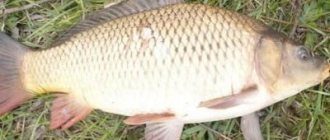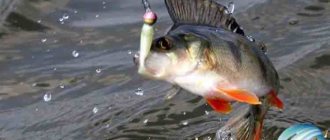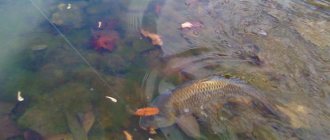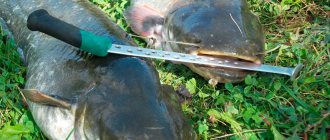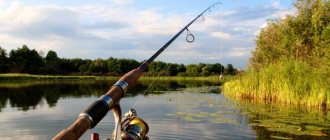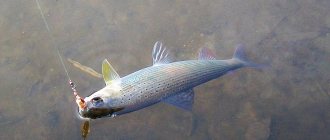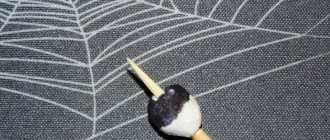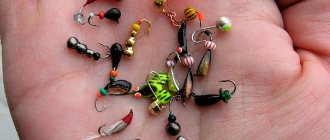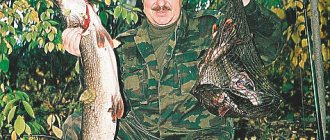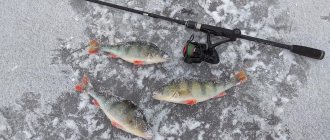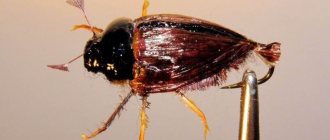Carp fishing in May: bait tricks
The dough for preparing May boilies should include only fresh natural products. Chemical flavors and artificial additives are best left aside and used at another time. For carp to like food, it must be sufficiently high in calories, digestible and healthy.
A bait with a natural taste that carp will definitely like. It is possible to accustom “wild” carp to boilies containing “chemicals,” but it will take a lot of time. Therefore, when going fishing in an unfamiliar body of water, bet on bait that has a familiar taste to carp.
It’s easy to catch crucian carp on a feeder in May
Among fishing enthusiasts, carp is considered a lazy fish that never changes its stopping place. A well-fed place is the basis for successfully catching this hooligan. But it's summer now. In May, crucian carp behave completely differently. In search of food, it runs around the pond, often swims to the shore, and then moves away from it several meters. Summer fishing tactics do not work: carp do not stay long even in previously baited places. And here the opinions of fishermen are divided: some believe that in no case should you use bait and look for fish with your feet, others cannot imagine a good catch without bait. The golden mean between these diametrically opposed opinions may lie in catching crucian carp in May on a feeder. Feeder equipment combines the attractiveness of fishing with mobility. It allows you to fish in several areas of the reservoir and find a new carp site.
A little about the feeder
Feeder is a bottom bait designed for casting over long distances. Even without leaving one spot, you can cast your gear to different distances, thereby exploring the water where the float rod should cause problems. Measuring the depth and setting the float takes a lot of time, but the feeder delivers the bait to the bottom regardless of the depth. In this case, the bait is given to the carp, as they say, “under the nose.”
Successful feeder fishing in May depends on the balance of gear. A light fishing rod is best suited for catching crucian carp. Clearly talks about taking careful fish. On a stiff rod, the bite will appear as a slightly noticeable, prolonged trembling of the tip. With a light rod, you will notice a few small tugs at first, followed by a clear bite. In addition, strong resistance from the rod can simply scare the back of the crucian carp - he will throw the bait and leave.
Suitable tackle for the feeder
It is better to put 0.2-0.3 mm thick braid on the crucible on the feeder: it stretches less and gives the lighthouse a careful bite of the fish. But as a leash, you should use a fishing line with a diameter of 0.12-0.16 mm: unlike braided fishing line, it does not bend. The length of the leash is no more than 30 cm, the bait should be located near the feeder.
The feeder can be installed in a variety of ways. In the absence of a currently proven "symmetrical loop".
In moderate current waters, it is recommended to use an "asymmetrical" loop and a "helicopter" loop.
Among the possible options for fastening the feeder, you can also assign a latch with counter rotation, however, it should be taken into account that pulling the pipe slightly unmasks the grip.
A video filmed on the Samara River in the Dnepropetrovsk region will tell us how to catch carp on a feeder in May.
Feeders
Light feeder rods weighing up to 20 grams are suitable for catching crucian carp. Among the products presented in fishing stores, you can choose LATTY Feeder INLINE and FLATTY Feeder PSP.
Their design feature is that they always lie on the bottom with the bait on top and do not bury themselves in the silt. The design of the feeder allows it to be easily moved along the bottom while feeding without any significant resistance that could scare away the carp.
Despite the fact that feeder rods of different weights and shapes are available in stores, many fishermen prefer to make their own from scrap materials. Choose plastic bottles, perforated plates, metal mesh and even women's curlers.
Curler feeder
To catch crucian carp, use thin hooks No. 10-16. The bait indicator on a feeder rod is a thin flexible tip, similar to a button on an ice fishing rod. It is removable and can be replaced with a tip of a different hardness. In the evening, when visibility is limited, it is recommended to use the bell. It is better to avoid lighting with a flashlight, as this may scare away the fish.
Carps at the feeder in May: video filmed on one of the Ural lakes.
Dung worms and wood grouse are used as spring bait for catching crucian carp. Fish need calories this time of year. protein food, so plant baits are ineffective. To prepare the bait, greens, corn flour, bran, and fried rye breadcrumbs are used as a basis. Carp is a fan of sweet and spicy aromas. Suitable aromas include vanilla, caramel, anise, and garlic. But you shouldn’t overdo it with aromas: too strong a smell may not attract, but, on the contrary, scare away the fish. This drawback is sometimes a sin when buying imported baits that are poorly adapted to our fishing conditions.
What to feed carp in May
In early spring, carp are still very sluggish and inactive! He does not have a good appetite. However, closer to summer it becomes noticeably livelier, but at the end of spring you should look for fish in algae thickets and snags, where they get their food. If you come to an unfamiliar body of water in May, then first look for dense thickets of aquatic vegetation. Most likely you will find carp in them. It is better to throw the rigs into clean spaces between islands of grass.
These paths are usually created by the carp themselves. Moving along them, it feeds on bloodworms, large quantities of which are hidden in a thick layer of silt. When choosing a fishing spot, consider the direction of the wind. You need to position yourself on the windward side, since the wind drives the heated top layer of water to the place where the gear is cast.
The feeding location of carp varies depending on the time of year. Even if you systematically fish in the same area, you will have to look for the biting place again each time. You can never tell in advance where the carp will feed, and where you should send the boat to bring in gear.
In early spring, it is important to choose the right bait composition. After wintering, carp do not need a lot of food. However, the food must be sufficiently high in calories and balanced in terms of vitamins and nutrients. The bait based on birdseed has proven itself to be the most effective.
To make it you will need the following set of products: • ground birdseed – 20%; • baby fish – 15%; • soy flour – 20%; • corn flour – 5%; • fishmeal – 15%; • flaxseed flour – 5%; • GLM concentrate – 3%; • cellulose – 3%; • amino acids – 1%; • flavor enhancer; • salt; • white pepper; • strawberry flavoring – 2-4 ml; • sweetener – 3 ml; • eggs – 10 pcs. per 1 kg of mixture.
Re-casting tackle
First you need to decide on the choice of gear. There are a large number of their varieties. Tackle can be bottom, feeder, you can also use ordinary float rods, etc.
Now about the reboot itself. Transfers are carried out every 30-40 minutes. At the same time, you should not forget to check the main fishing point and its boundaries. Of course, as was written earlier, carp are afraid of all extraneous noises. But it is in May - before spawning, his attention is dulled and this can be taken advantage of
Re-casting of gear is necessary in order to frequently update the bait and deliver the latest portion of bait to the fishing point. The baits must be changed at such a frequency that they do not have time to completely absorb the aroma of the reservoir, thereby becoming uninteresting to the fish.
Despite the large number of recasts and bait changes, the carp still needs to be fed. This will help attract large carp to the fishing spot. The first supplementary feeding should be carried out 4-6 hours after the initial feeding. But this, of course, also depends on the time of day and the activity of the fish.
What tactics to use to catch carp in May
The first step in the spring is to provide a good starting feed. To do this, you need to make 30-40 casts of a feeder tightly filled with the prepared mixture to the selected cool point. This will attract small fish, followed by large ones.
Article on the topic: carp fishing in autumn, bait
By this time, you will already be sending to a cool feeder with all the equipment. Recasts should be done every half hour, updating the bait and bait. Otherwise, the chances of attracting fish and getting a bite are noticeably reduced.
In addition, during a long period of carp fishing in May, it will also be necessary to feed it additionally. This should be done 5 hours after the starting feeding.
And one more feature: you should cast not only to the cool point itself, but also, periodically, at a distance of several meters to the side from it. The fact is that small carp usually feed at the feeding site, while larger and more careful individuals often eat at the borders of the site.
Groundbaits and baits. Flavoring of bait and dip
There are several ways to catch carp. One of them is based on generous feeding. Not much attention is paid to finding the right place; the main thing is to feed the carp in the evening the day before fishing, and then feed it in the morning.
In May, when feeding carp, it is best to choose regular mixtures (that is, those that do not have their own smell). For what reason? The fact is that spring is a time of very strong odors. To kill them, you need to have something strong-smelling in your arsenal. But then the other extreme is that too strong a smell can only scare away the fish.
Professionals advise using alcohol-based flavors at this time of year. Or based on hemp seeds and molasses. In general, ideally, the carp should be given 20 kilograms of bait in the evening, and another ten in the morning. But, of course, in reservoirs where there is little food, you can use less bait
The main thing is not to forget to add something to the bait that you will then use as bait. Moreover, the nozzle should preferably be about half of the total weight of the bait.
What should you use as carp bait in May?
The following types of nozzles are suitable:
- corn or peas - you can use the kind that are sold in jars. Excellent bait for carp.
- worm and maggot - like almost any fish, carp readily bites on this type of bait.
- pearl barley, dough, bread are also suitable for carp fishing.
For good fishing, it is better to use several of the listed attachments. To flavor baits, you can use dips by dipping the finished bait into liquid. The requirements for the dip are the same as for other flavors - the main thing is that the smell is not strong, but natural.
By the way, they say that carp react positively to combinations of baits. For example, if you put a worm and maggot or a worm and corn on one hook.
Carp fishing in May
The last month of spring is a favorable time for catching large and even trophy specimens. This is the time when the fish has already forgotten about hibernation and begins its preparation for spawning; this is a period of intense feeding. This is why carp fishing in May, especially at the beginning, is so promising: there is an excellent chance of returning home with good catch. Moreover, during spawning, the fish will no longer be so willing to peck, and for some time afterwards they will show complete passivity.
We suggest you look at where, what and how to catch carp in May in order to catch it before it becomes cautious and picky. Let's choose a place, bait and bait for fishing. Let’s also pay proper attention to the tactics of feeding and recasting.
Carp fishing tactics
Carp is a very cautious fish and the older it is, the more timid it becomes. Of course, a well-chosen place and time for fishing, good bait and bait can help in catching it. But this alone is not enough if you are not careful.
You need to follow some rules:
- Avoid noise when fishing. The golden rule of all fishermen. And it especially concerns carp.
- Choose clothes that will blend in with the shore and surroundings, preferably something darker. Otherwise, the carp will notice bright unnatural colors and this will scare them away.
- It is better to place the bait not on the hook itself, but on the hair - this is a small piece of fishing line or monofilament that is threaded through the bait. This is done for the following reason: before swallowing the bait, the carp tastes it and sucks it. Therefore, there may be light bites and you should hook only after the float has already gone too clearly under the water.
- You need to carefully remove the fish from the water. After all, carp is a fairly large fish and you can end up without a fishing line or with a broken rod.
Compliance with all of the above rules will significantly increase the chances of successfully catching carp.
What do crucian carp bite on in May: feeding recipes, tackle, bait
In the spring, carp fishing is a very exciting activity that can be successfully practiced in various bodies of water. At this time of year, the carp are very active, after the spawning period they begin to go crazy. The period of increased activity of this fish occurs in May and lasts until the second ten days of June.
During this time, you catch carp using almost all natural baits for animals or plants known to the fisherman.
What do crucian carp bite on in May?
Muckworm. Arrows. Mosquito. Burdock moth larvae. Corn. Coleslaw. Bread and cakes.
Despite the increased appetite of carp at this time of year, it is impossible to do without high-quality bait.
Bait for catching crucian carp
There are a huge number of bait mixtures for carp fishing, which can be purchased at any fishing store, but if the bait is made with your own hands, practice shows that catches of this fish increase several times when using a mixture prepared independently.
Bait recipes for crucian carp
The most popular bait recipe for crucian carp consists of the following ingredients:
Millet grain. Pearl porridge. Mann semolina. Sunflower cake. Breadcrumbs.
The bait is prepared in the following order:
Pour water into a saucepan with a capacity of at least 3 liters, approximately 2/3 of the volume. Place the pan on the fire and bring the water to a boil. Pour 200 g of pearl millet into boiling water and cook the cereal for 20 minutes. Then add 200 g of millet to the pearl barley and cook for another 30 minutes. Then add 100 g of semolina and boil for another 10 minutes. Then remove the pan from the heat and add sunflower cake - 100 g and breadcrumbs - 100 g.
Stir the mixture thoroughly and let it cool in the same bowl.
When preparing bait, stir the mixture constantly. When the mixture boils, reduce the heat to prevent the cereal from sticking. During cooking, you can add a small amount of water if necessary.
Pea bait is no less popular for catching this fish.
The cooking process occurs in the following sequence:
Pour 2 liters of water into an enamel pan. Add 500 g peas. Cook the peas for 1.5 hours over low heat. Grind the peas using a potato masher.
The resulting pea puree can be seasoned with unrefined sunflower oil or dill juice, but even if we do not do this, the smell of peas can attract fish from a distance.
The third method, but no less effective than those described above, is buckwheat.
A very simple cooking method, which consists in stewing buckwheat in water over low heat for 40 minutes.
Cereals can be used in their pure form, but baits seasoned with unrefined sunflower oil usually give better results.
Features of feeding crucian carp
If it is possible to feed for several days at the catch site, this is the most effective way to attract carp with bait mixtures. This method works well in tanks where there is little or no electricity.
The most important thing when carrying out bait is to correctly calculate the amount of bait that will be completely absorbed by underwater inhabitants. Otherwise, you can get a counterproductive effect due to rotting of food debris in this part of the container.
Carp bait
In order for carp to bite well, you need high-quality bait. Carp cannot overfeed at all, so in this case, bait will only be an additional advantage when fishing for carp.
In spring, the following components are added to the bait:
- Worm.
- Bloodworm.
- Boyle.
- Chopped worm.
- Cereals (added in summer).
- Porridge.
- Fish preparations.
- Mashed potatoes.
Professional fishermen use rocket launchers that can quickly spread bait over a larger area.
The most effective complementary foods and attachments
Many anglers know that the use of different types of bait depends on the season of their use. Carp in May is no exception, so during this period it is better to use odorless components, but with the addition of spruce a perceptible flavoring. It is good to use corn or peas as bait in May.
Fishing process
How easy and effective carp fishing in May will be, and whether it will bring the desired catch, in most cases depends on the fishing tactics used.
Having decided on a promising fishing spot, you need to feed it. To do this, you need to throw plenty of bait, as a rule, 10-12 kg may be needed. Initially, it will attract small fish, which react faster than large fish to complementary feeding. But this little thing will not be able to swallow the peas and corn present in the complementary foods, so our long-awaited carp will get all the further pleasure from eating food. Throughout the fishing, you will need to regularly continue to feed the fish. The first supplementary feeding must be done 4-6 hours after the starting one.
Next, you need to arrange your gear and wait for a bite. Re-casting must be done every half hour. This is done to update the bait, otherwise it may absorb various pond odors and stop attracting fish. Since in the spring season the carp is in a state of pre-spawning feast, it does not particularly react to extraneous noise, so you can safely recast the bait.
Before catching carp in May, you need to take into account one more feature: in the main feeding areas there are most often small-sized carp, but larger individuals stay at a distance of 5-10 meters from this place. Therefore, it happens that more intense bites occur in these places. Take this into account and check for the presence of carp in both places.
